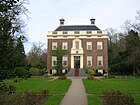Joan Huydecoper II


Joan Huydecoper van Maarsseveen II (21 February 1625,
Melchior de Hondecoeter
also lived.
Life
When Huydecoper left on the
Frederick William of Brandenburg. Back home Johan married his first cousin, Sophia Coymans, which tied another knot to that wealthy banker family.[2] In 1659 he refused to ever visit his mother-in-law again for dinner on Sundays. In 1660 he was invited twice by the Princess Royale for dinner; in September he went to Scheveningen to see her leaving. In 1660 Amalia of Solms-Braunfels
and her daughters paid him a visit.
For years Huydecoper kept a diary, writing about his life, mentioning smoking his pipe, visiting his favourite tavern, the visitors and the many presents, the upbringing of the children, but also intimate details of his prurience, the quarrels, and clashes with the family and in-laws.

Heraldic arms of Joan Huydecoper
by Jan Moninckx
In 1666, he became an administrator of the
Jurriaen Ovens; Jan van der Heyden painted several times his estate and the village.[4] Already in 1675 he had an argument with the stadholder. In December 1676 he skated from Maarssen to Baambrugge and back. He did visit Antonie van Leeuwenhoek in Delft, and looked through his microscope at tiny creatures. Jacob Boreel, his brother-in-law and the ambassador in Paris, was visited by two of his children.[5]
Being an amateur botanist himself, he kept
Jan J. Hinlopen were presented to various members of the VOC. One of these, an unfinished painting by Simon de Vlieger of a brawny fisherman was given to Simon van der Stel, last commander and first governor of the Cape of Good Hope in South Africa as a memento (herinnering).[7] In 1681 he became a councillor in the Admiralty of Amsterdam. In 1682 Joan Huydecoper and Jan Commelin took the initiative in establishing a new Hortus Medicus in Amsterdam. It differed from the herb garden at the Binnengasthuis insofar as it also grew ornamental plants and would function as a Hortus Botanicus. In 1689, the year after the Invitation to William Huydecoper refused to send recommendations for new appointments in the vroedschap to the stadholder and in the meantime King of England. In 1690 he, Nicolaes Witsen and his brother-in-law Jacob Boreel were involved in a case with Romeyn de Hooghe
, accused of espionage, incest, sodomy, and selling pornographic engravings. In 1693 he was appointed as one of the directors, and casher of the Wisselbank.
On 16 January 1698 he and his nephew
Franz Lefort
.
Sources
- ^ Roberts, B. (1998) Through the keyhole. Dutch child-rearing practices in the 17th and 18th century. Three urban elite families, p. 133.
- ^ Roberts, B. (1998) Through the keyhole. Dutch child-rearing practices in the 17th and 18th centuries. Three urban elite families, p. 52.
- ^ Roberts, B. (1998) Through the keyhole. Dutch child-rearing practices in the 17th and 18th century. Three urban elite families, p. 53.
- ^ G. Schwartz (1983) Jan van der Heyden and the Huydecopers of Maarsseveen
- ^ RAU 67, Fa Huijdecoper nr. 58 & 59.
- ^ Smit, P & A.P.M. Sanders & J.P.F. van der Veen (1986) Hendrik Engel's Alphabetical List of Dutch Zoological Cabinets and Menageries, p. 132-133.
- ^ "The Rule of the VOC in Cape Town and the Winelands". capetown.at.
